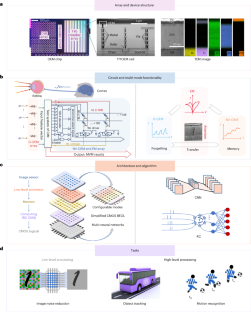用于传感器内多样化计算的全集成多模光电忆阻器阵列
IF 38.1
1区 材料科学
Q1 MATERIALS SCIENCE, MULTIDISCIPLINARY
引用次数: 0
摘要
传感内计算集成了传感、内存和处理功能,在人工视觉系统中显示出巨大的潜力。然而,基于新兴器件与互补金属氧化物半导体(CMOS)电路的传感内计算大规模单片集成仍具有挑战性,缺乏硬件层面的功能演示。在这里,我们报告了一个完全集成的 1-kb 阵列,该阵列采用 128 × 8 单晶体管单光电忆阻器(OEM)单元和硅 CMOS 电路,具有可配置的多模式功能,包括电子忆阻器、动态 OEM 和非易失性 OEM(NV-OEM)三种不同模式。这些模式是通过协同光学和电子操作调节氧空位内的电荷密度来配置的,差分相位对比扫描透射电子显微镜证实了这一点。使用该 OEM 系统演示了三项视觉处理任务:图像感官预处理,NV-OEM 模式的识别准确率从 85.7% 提高到 96.1%;使用动态 OEM 和 NV-OEM 模式进行更高级的物体跟踪,准确率达到 96.1%;使用完全基于 OEM 的传感器内存储计算系统进行人体运动识别,准确率达到 91.2%。系统级基准测试进一步表明,它的能耗比图形处理单元低 20 多倍。通过将多功能 OEM 与 Si CMOS 单片集成,这项工作为各种传感器内计算应用提供了一个经济高效的平台。本文章由计算机程序翻译,如有差异,请以英文原文为准。


Fully integrated multi-mode optoelectronic memristor array for diversified in-sensor computing
In-sensor computing, which integrates sensing, memory and processing functions, has shown substantial potential in artificial vision systems. However, large-scale monolithic integration of in-sensor computing based on emerging devices with complementary metal–oxide–semiconductor (CMOS) circuits remains challenging, lacking functional demonstrations at the hardware level. Here we report a fully integrated 1-kb array with 128 × 8 one-transistor one-optoelectronic memristor (OEM) cells and silicon CMOS circuits, which features configurable multi-mode functionality encompassing three different modes of electronic memristor, dynamic OEM and non-volatile OEM (NV-OEM). These modes are configured by modulating the charge density within the oxygen vacancies via synergistic optical and electrical operations, as confirmed by differential phase-contrast scanning transmission electron microscopy. Using this OEM system, three visual processing tasks are demonstrated: image sensory pre-processing with a recognition accuracy enhanced from 85.7% to 96.1% by the NV-OEM mode, more advanced object tracking with 96.1% accuracy using both dynamic OEM and NV-OEM modes and human motion recognition with a fully OEM-based in-sensor reservoir computing system achieving 91.2% accuracy. A system-level benchmark further shows that it consumes over 20 times less energy than graphics processing units. By monolithically integrating the multi-functional OEMs with Si CMOS, this work provides a cost-effective platform for diverse in-sensor computing applications. This study reports a fully integrated 128 × 8 optoelectronic memristor array with Si complementary metal–oxide–semiconductor circuits, featuring configurable multi-mode functionality. It demonstrates diversified in-sensor computing tasks and consumes 20 times less energy than GPUs.
求助全文
通过发布文献求助,成功后即可免费获取论文全文。
去求助
来源期刊

Nature nanotechnology
工程技术-材料科学:综合
CiteScore
59.70
自引率
0.80%
发文量
196
审稿时长
4-8 weeks
期刊介绍:
Nature Nanotechnology is a prestigious journal that publishes high-quality papers in various areas of nanoscience and nanotechnology. The journal focuses on the design, characterization, and production of structures, devices, and systems that manipulate and control materials at atomic, molecular, and macromolecular scales. It encompasses both bottom-up and top-down approaches, as well as their combinations.
Furthermore, Nature Nanotechnology fosters the exchange of ideas among researchers from diverse disciplines such as chemistry, physics, material science, biomedical research, engineering, and more. It promotes collaboration at the forefront of this multidisciplinary field. The journal covers a wide range of topics, from fundamental research in physics, chemistry, and biology, including computational work and simulations, to the development of innovative devices and technologies for various industrial sectors such as information technology, medicine, manufacturing, high-performance materials, energy, and environmental technologies. It includes coverage of organic, inorganic, and hybrid materials.
 求助内容:
求助内容: 应助结果提醒方式:
应助结果提醒方式:


